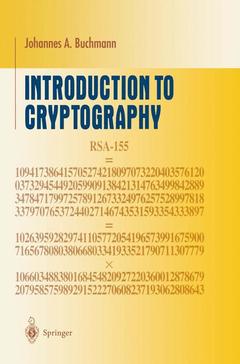Introduction to Cryptography, Softcover reprint of the original 1st ed. 2001 Undergraduate Texts in Mathematics Series
Langue : Anglais
Auteur : Buchmann Johannes

Riemannian geometry has today become a vast and important subject. This new book of Marcel Berger sets out to introduce readers to most of the living topics of the field and convey them quickly to the main results known to date. These results are stated without detailed proofs but the main ideas involved are described and motivated. This enables the reader to obtain a sweeping panoramic view of almost the entirety of the field. However, since a Riemannian manifold is, even initially, a subtle object, appealing to highly non-natural concepts, the first three chapters devote themselves to introducing the various concepts and tools of Riemannian geometry in the most natural and motivating way, following in particular Gauss and Riemann.
1 Integers.- 1.1 Basics.- 1.2 Divisibility.- 1.3 Representation of Integers.- 1.4 O- and ?-Notation.- 1.5 Cost of Addition, Multiplication, and Division with Remainder.- 1.6 Polynomial Time.- 1.7 Greatest Common Divisor.- 1.8 Euclidean Algorithm.- 1.9 Extended Euclidean Algorithm.- 1.10 Analysis of the Extended Euclidean Algorithm.- 1.11 Factoring into Primes.- 1.12 Exercises.- 2 Congruences and Residue Class Rings.- 2.1 Congruences.- 2.2 Semigroups.- 2.3 Groups.- 2.4 Residue Class Rings.- 2.5 Fields.- 2.6 Division in the Residue Class Ring.- 2.7 Analysis of Operations in the Residue Class Ring.- 2.8 Multiplicative Group of Residues.- 2.9 Order of Group Elements.- 2.10 Subgroups.- 2.11 Fermat’s Little Theorem.- 2.12 Fast Exponentiation.- 2.13 Fast Evaluation of Power Products.- 2.14 Computation of Element Orders.- 2.15 The Chinese Remainder Theorem.- 2.16 Decomposition of the Residue Class Ring.- 2.17 A Formula for the Euler ?-Function.- 2.18 Polynomials.- 2.19 Polynomials over Fields.- 2.20 Structure of the Unit Group of Finite Fields.- 2.21 Structure of the Multiplicative Group of Residues mod a Prime Number.- 2.22 Exercises.- 3 Encryption.- 3.1 Encryption Schemes.- 3.2 Symmetric and Asymmetric Cryptosystems.- 3.3 Cryptanalysis.- 3.4 Alphabets and Words.- 3.5 Permutations.- 3.6 Block Ciphers.- 3.7 Multiple Encryption.- 3.8 Use of Block Ciphers.- 3.9 Stream Ciphers.- 3.10 Affine Cipher.- 3.11 Matrices and Linear Maps.- 3.12 Affine Linear Block Ciphers.- 3.13 Vigenère, Hill, and Permutation Ciphers.- 3.14 Cryptanalysis of Affine Linear Block Ciphers.- 3.15 Exercises.- 4 Probability and Perfect Secrecy.- 4.1 Probability.- 4.2 Conditional Probability.- 4.3 Birthday Paradox.- 4.4 Perfect Secrecy.- 4.5 Vernam One-Time Pad.- 4.6 Random Numbers.- 4.7 Pseudorandom Numbers.- 4.8 Exercises.- 5 DES.- 5.1 Feistel Ciphers.- 5.2 DES Algorithm.- 5.3 An Example.- 5.4 Security of DES.- 5.5 Exercises.- 6 Prime Number Generation.- 6.1 Trial Division.- 6.2 Fermat Test.- 6.3 Carmichael Numbers.- 6.4 Miller-Rabin Test.- 6.5 Random Primes.- 6.6 Exercises.- 7 Public-Key Encryption.- 7.1 Idea.- 7.2 RSA Cryptosystem.- 7.3 Rabin Encryption.- 7.4 Diffie-Hellman Key Exchange.- 7.5 ElGamal Encryption.- 7.6 Exercises.- 8 Factoring.- 8.1 Trial Division.- 8.2 p — 1 Method.- 8.3 Quadratic Sieve.- 8.4 Analysis of the Quadratic Sieve.- 8.5 Efficiency of Other Factoring Algorithms.- 8.6 Exercises.- 9 Discrete Logarithms.- 9.1 DL Problem.- 9.2 Enumeration.- 9.3 Shanks Baby-Step Giant-Step Algorithm.- 9.4 Pollard ?-Algorithm.- 9.5 Pohlig-Hellman Algorithm.- 9.6 Index Calculus.- 9.7 Other Algorithms.- 9.8 Generalization of the Index Calculus Algorithm.- 9.9 Exercises.- 10 Cryptographic Hash Functions.- 10.1 Hash Functions and Compression Functions.- 10.2 Birthday Attack.- 10.3 Compression Functions from Encryption Functions.- 10.4 Hash Functions from Compression Functions.- 10.5 Efficient Hash Functions.- 10.6 An Arithmetic Compression Function.- 10.7 Message Authentication Codes.- 10.8 Exercises.- 11 Digital Signatures.- 11.1 Idea.- 11.2 RSA Signatures.- 11.3 Signatures from Public-Key Systems.- 11.4 ElGamal Signature.- 11.5 Digital Signature Algorithm (DSA).- 11.6 Exercises.- 12 Other Groups.- 12.1 Finite Fields.- 12.2 Elliptic Curves.- 12.3 Quadratic Forms.- 12.4 Exercises.- 13 Identification.- 13.1 Passwords.- 13.2 One-Time Passwords.- 13.3 Challenge-Response Identification.- 13.4 Exercises.- 14 Public-Key Infrastructures.- 14.1 Personal Security Environments.- 14.2 Certification Authorities.- 14.3 Certificate Chains.- References.- Solutions to the Exercises.
Date de parution : 01-2012
Ouvrage de 281 p.
15.5x23.5 cm
Disponible chez l'éditeur (délai d'approvisionnement : 15 jours).
Prix indicatif 52,74 €
Ajouter au panierThèmes d’Introduction to Cryptography :
© 2024 LAVOISIER S.A.S.
